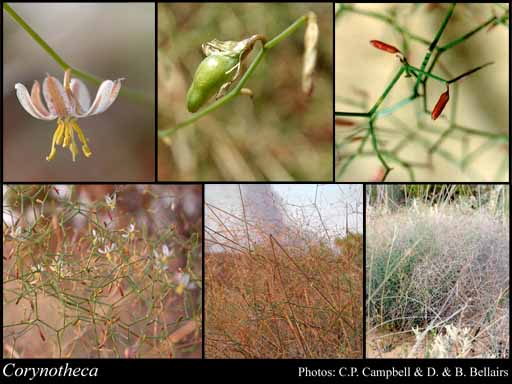- Reference
- Fl.Austral. 7:49 (1878)
- Name Status
- Current

Scientific Description
Family Anthericaceae.
Sometimes included in Liliaceae.
Habit and leaf form. Shrubs (shrub-like), or herbs (tufted, the aerial stems erect, much branched, short, slender, rigid and leafy); evergreen, or deciduous. ‘Normal’ plants, or switch-plants; with the principal photosynthesizing function transferred to stems. Leaves much reduced, or absent (absent in mature plants as they wither away early). Perennial. Leaves basal. Plants with a basal concentration of leaves, or with neither basal nor terminal concentrations of leaves; rhizomatous. Self supporting, or climbing. Mesophytic, or xerophytic. Leaves alternate; spiral, or distichous; ‘herbaceous’, or leathery, or membranous; sessile; sheathing. Leaf sheaths not tubular; with free margins. Leaves edgewise to the stem, or with ‘normal’ orientation; simple. Leaf blades entire; flat, or folded, or solid (or triquetrous); linear, or lanceolate, or oblong, or ovate; narrow; parallel-veined; without cross-venules; sheathing. Leaves ligulate, or eligulate; without stipules. Leaf blade margins entire. Leaf anatomy. Hairs absent (usually). Extra-floral nectaries absent. Stem anatomy. Secondary thickening absent.
Reproductive type, pollination. Fertile flowers hermaphrodite. Unisexual flowers absent. Plants hermaphrodite. Floral nectaries present. Nectar secretion from the gynoecium (from septal nectaries).
Inflorescence and flower features. Flowers aggregated in ‘inflorescences’ (perennating); in racemes (spike-like), or in panicles (irregular). The terminal inflorescence unit cymose, or racemose (simple or compound). Inflorescences scapiflorous; terminal; inflorescence intricately many branched; flowers small, solitary or in clusters of 2–6 along the racemules or in the branch axils; with involucral bracts, or without involucral bracts; pseudanthial, or not pseudanthial. Flowers pedicellate (articulate at the apex); bracteate (inconspicuous, subtend lower branches, elongated, leaf-like, wither at flowering); bracteolate (1 minute bract and a bracteole subtend 1 or 2 flowers (of different ages) per node); small, or medium-sized; regular (more or less); 3 merous; cyclic; pentacyclic, or tetracyclic. Perigone tube present, or absent. Perianth with distinct calyx and corolla (the whorls rather different), or of ‘tepals’; 6; 2 -whorled (3+3); isomerous; free, or joined; petaloid; similar in the two whorls, or different in the two whorls; white, or red, or yellow, or blue, or violet. Calyx (if the outer whorl so interpreted) 3; 1 -whorled; regular. Corolla (if the inner whorl so interpreted) 3; 1 -whorled; regular. Corolla members sometimes fringed. Androecial members definite in number. Androecium 6. Androecial members adnate; markedly unequal; free of one another; 1 -whorled, or 2 -whorled. Androecium exclusively of fertile stamens, or including staminodes. Staminodes when present, 3. Stamens 6; those opposite the inner perianth lobes a little longer; all more or less similar in shape; isomerous with the perianth, or diplostemonous; at the base of the perianth lobes, epipetalous; alterniperianthial, or oppositiperianthial. Anthers near the base; versatile; dehiscing via longitudinal slits; introrse; tetrasporangiate. Gynoecium 3 carpelled. The pistil 3 celled. Carpels isomerous with the perianth. Gynoecium syncarpous; synstylovarious, or eu-syncarpous; superior. Ovary plurilocular; 3 locular; sessile. Gynoecium stylate. Styles 1; apical (or nearly so). Stigmas 1; 2–3 - lobed; capitate. Placentation axile. Ovules 1–2 per locule; arillate; campylotropous (generally), or anatropous.
Fruit and seed features. Fruit non-fleshy; dehiscent (capsule tardily dehiscent along 1 side), or indehiscent (nut-like indehiscent or rupturing); a capsule, or capsular-indehiscent. Capsules splitting irregularly, or loculicidal. Fruit 1(–2) seeded. Seeds endospermic; arillate. Cotyledons 1. Embryo straight to curved.
Additional characters Pollen grains trichotomosulcate.